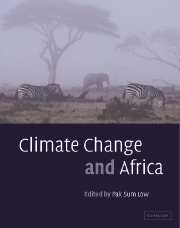Book contents
- Frontmatter
- Contents
- Notes on contributors
- Peer reviewers
- Editor's note
- Foreword
- Foreword
- Foreword
- Foreword
- Preface
- Preface
- Preface
- Preface
- List of abbreviations
- List of SI prefixes
- List of unit abbreviations
- List of chemical formulae
- Part I Science
- 1 Holocene climatic, hydrological and environmental oscillations in the tropics with special reference to Africa
- 2 The relative importance of the different forcings on the environment in Ethiopia during the Holocene
- 3 Global warming and African climate change: a reassessment
- 4 Interactions of desertification and climate in Africa
- 5 Africa's climate observed: perspectives on monitoring and management of floods, drought and desertification
- 6 Atmospheric chemistry in the tropics
- 7 Natural and human-induced biomass burning in Africa: an important source for volatile organic compounds in the troposphere
- 8 Biomass burning in Africa: role in atmospheric change and opportunities for emission mitigation
- 9 Soil micro-organisms as controllers of trace gas emissions over southern Africa
- Part II Sustainable energy development, mitigation and policy
- Part III Vulnerability and adaptation
- Part IV Capacity-building
- Part V Lessons from the Montreal Protocol
- Index
4 - Interactions of desertification and climate in Africa
Published online by Cambridge University Press: 10 December 2009
- Frontmatter
- Contents
- Notes on contributors
- Peer reviewers
- Editor's note
- Foreword
- Foreword
- Foreword
- Foreword
- Preface
- Preface
- Preface
- Preface
- List of abbreviations
- List of SI prefixes
- List of unit abbreviations
- List of chemical formulae
- Part I Science
- 1 Holocene climatic, hydrological and environmental oscillations in the tropics with special reference to Africa
- 2 The relative importance of the different forcings on the environment in Ethiopia during the Holocene
- 3 Global warming and African climate change: a reassessment
- 4 Interactions of desertification and climate in Africa
- 5 Africa's climate observed: perspectives on monitoring and management of floods, drought and desertification
- 6 Atmospheric chemistry in the tropics
- 7 Natural and human-induced biomass burning in Africa: an important source for volatile organic compounds in the troposphere
- 8 Biomass burning in Africa: role in atmospheric change and opportunities for emission mitigation
- 9 Soil micro-organisms as controllers of trace gas emissions over southern Africa
- Part II Sustainable energy development, mitigation and policy
- Part III Vulnerability and adaptation
- Part IV Capacity-building
- Part V Lessons from the Montreal Protocol
- Index
Summary
Keywords
Desertification; climate change
Abstarct
Much of the scientific literature dealing with interactions of desertification and climate is based upon hundreds of studies dealing with the African continent. Three decades ago, the severe drought in sub-Saharan Africa generated an extensive discussion of whether overgrazing and land degradation in the region had produced atmosphere/land surface feedbacks that exacerbated drought throughout the Sahel. Related studies focusing on the possibility of desertification producing warming trends in historical temperature records were also based on African data sets. Furthermore, evidence from southern Africa suggests that land degradation in drylands can lead to warmer afternoon temperatures and an increase in the diurnal temperature range; this finding is opposite of the decline in diurnal temperature range reported throughout most of the world. Many articles have appeared in the literature showing how variations in the climate system can impact drought conditions in Africa, and the linkages between sea surface conditions, atmospheric circulation, and precipitation patterns in Africa are reasonably well known thanks to this research. In most recent years, a substantial literature has developed regarding how anthropogenic greenhouse-induced climate changes could impact the African continent. Generally speaking, climate models suggest that a build-up of greenhouse gases in the atmosphere could lead to a warming of Africa, increased potential evapotranspiration rates, a reduction of soil moisture, and an increase in the frequency, intensity and magnitude of droughts.
- Type
- Chapter
- Information
- Climate Change and Africa , pp. 41 - 49Publisher: Cambridge University PressPrint publication year: 2005
- 4
- Cited by



